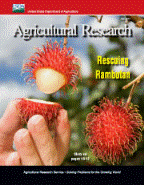United States Department of Agriculture: Agricultural Research Service, Lincoln, Nebraska

Agricultural Research Magazine
Date of this Version
5-2013
Document Type
Article
Citation
Agricultural Research May/June 2013
Abstract
Though the price makes you wince, you might just buy that bottle of your favorite olive oil anyway. Perhaps it’s exactly what you want for the salad dressing you’re making tonight and for your special stir-fry on the weekend. But are you really getting what you paid for?
A bottle proclaiming that it is olive oil might actually include another, lessexpensive vegetable oil derived from, for example, safflower or canola. Mislabeling is of concern not just to shoppers, retailers, and chefs, but also to America’s olive growers, olive oil processors, and more—especially those newly entering the U.S. olive oil market. California, which already produces the bulk of the nation’s olives, is experiencing a resurgence of interest in producing more of this popular vegetable oil, even in the face of significant international competition: Today, about 98 percent of all olive oil consumed in the United States is imported.
Scientists at the Agricultural Research Service’s Western Regional Research Center in Albany, California, are contributing research findings that may strengthen the domestic olive oil industry.
Talwinder Kahlon and Ken (Jiann-Tsyh) Lin, for instance, have developed analytical methods that can be used to assure the authenticity of olive oil. Rebecca Milczarek is investigating opportunities for making better use of the olive-milling byproducts that are left once the plump fruit, or “drupe,” has been processed to extract its oil. Mendel Friedman and colleagues have shown the effectiveness of olive powder for a perhaps surprising task: keeping hamburger patties safe to eat.
Included in
Agriculture Commons, Animal Sciences Commons, Food Science Commons, Plant Sciences Commons

